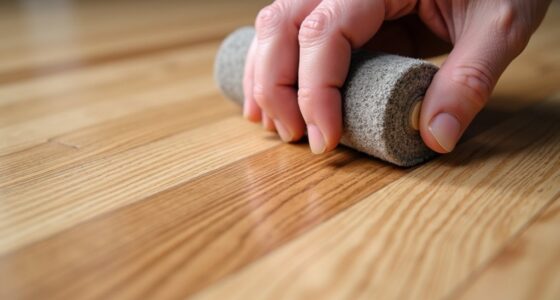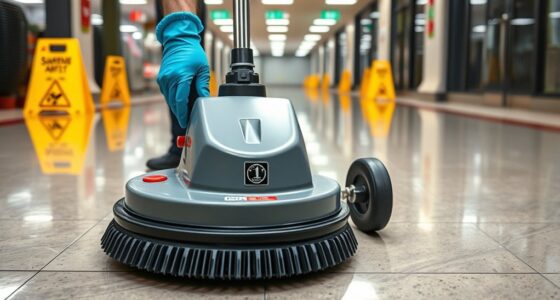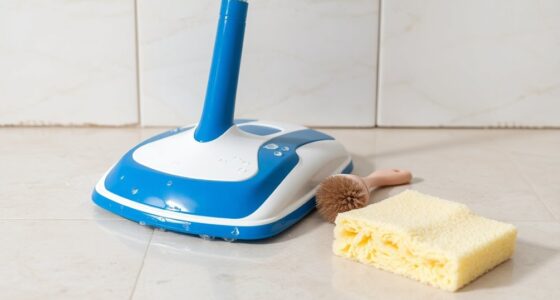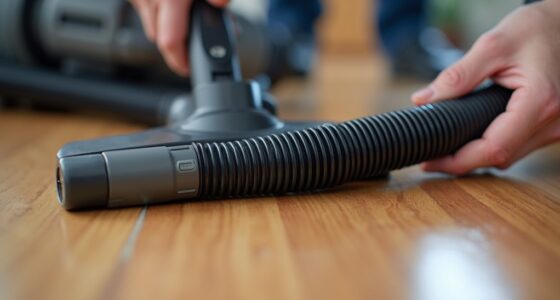You should definitely pre-sweep your epoxy floors before applying the coating. This step removes loose debris, dust, and dirt that can prevent proper adhesion and cause future problems like peeling or bubbles. Using a sturdy broom and vacuum ensures a clean surface, setting a solid foundation for the epoxy. Skipping pre-sweeping can compromise the finish, so it’s a vital part of surface preparation. Keep going to discover more tips for a lasting epoxy application.
Key Takeaways
- Pre-sweeping is essential to remove loose debris, dust, and dirt before epoxy application for optimal adhesion.
- It helps prevent surface imperfections like bubbles, unevenness, or peeling over time.
- Use sturdy brooms and vacuuming to thoroughly clean the surface, especially corners and tight spaces.
- Skipping pre-sweeping can lead to contaminants that weaken epoxy bonding and compromise durability.
- Always inspect the surface post-sweeping to ensure it’s free of debris and ready for further cleaning or prep.
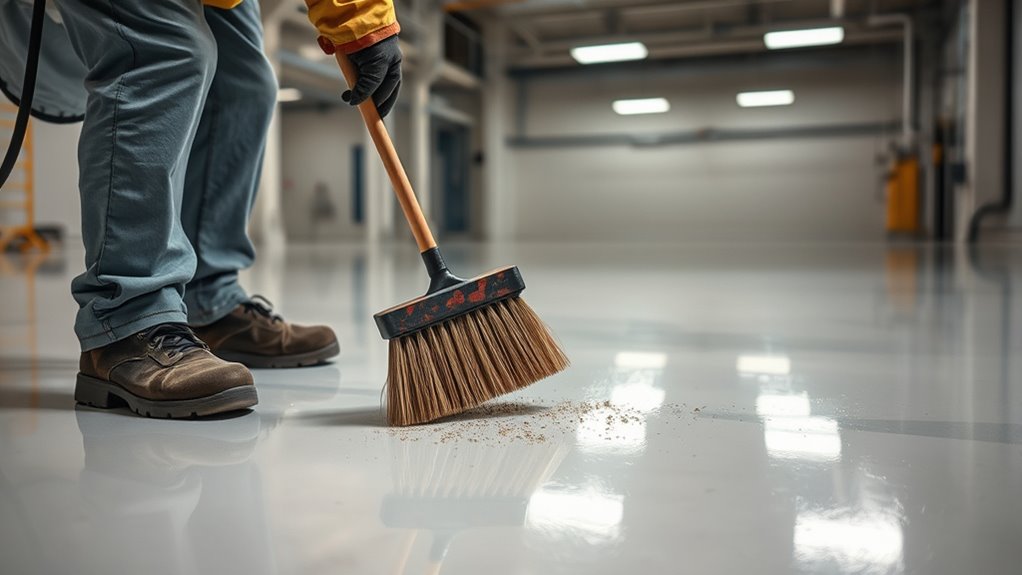
Before applying epoxy floors, you need to start with a thorough pre-sweep to guarantee a smooth, long-lasting finish. This initial step is essential because it sets the foundation for proper surface preparation. Using the right cleaning equipment, such as brooms and vacuums, helps you remove loose debris, dust, and dirt that could otherwise compromise the adhesion of the epoxy coating. Skipping this step or rushing through it can lead to uneven surfaces, bubbles, or peeling over time, which defeats the purpose of investing in a durable epoxy floor.
Effective surface preparation begins with a detailed pre-sweep. You should use a sturdy broom or a commercial-grade push broom designed for industrial or garage floors. These tools are built to handle large debris and to reach into corners and tight spaces. After sweeping, it’s a good idea to use a shop vacuum or industrial vacuum cleaner to pick up fine dust and small particles that sweeping alone might miss. This combination ensures the surface is as clean as possible before moving on to more intensive cleaning methods. Remember, the goal is to eliminate all loose debris and dust, as even tiny particles can interfere with epoxy adhesion.
Pre-sweeping isn’t just about cleanliness; it’s about surface preparation. A well-prepared surface allows the epoxy to bond properly, preventing future issues like lifting or peeling. Once you’ve removed loose debris, inspect the floor for any oil stains, grease, or other contaminants. These need to be addressed with appropriate cleaning agents or degreasers before proceeding. Failure to do so can create weak spots in the coating, risking damage or failure down the line.
In many cases, a thorough pre-sweep is enough for concrete floors that are relatively clean and free of stains. However, if your surface has stubborn dirt, grease, or existing coatings, additional cleaning steps like scrubbing with a concrete cleaner or applying a mechanical grinder might be necessary. But the first step always remains the same: a detailed pre-sweep using the right cleaning equipment to set the stage for proper surface preparation.
Additionally, understanding the importance of surface cleanliness is crucial, as adhesion strength greatly depends on a properly prepared substrate.
Frequently Asked Questions
Can I Skip Pre-Sweeping if My Epoxy Floor Appears Clean?
You shouldn’t skip pre-sweeping even if your epoxy floor looks clean because dust removal is vital for proper surface preparation. Small particles and debris can hide and cause issues during sealing or coating, leading to poor adhesion and future damage. Always give your floor a thorough pre-sweep to guarantee a smooth, long-lasting finish. Proper surface preparation makes a significant difference in the durability and appearance of your epoxy floor.
How Often Should I Pre-Sweep Epoxy Floors for Maintenance?
You should pre-sweep epoxy floors daily if you notice floor dust or debris buildup. Regular debris removal prevents scratches and maintains the floor’s appearance. For light use areas, weekly pre-sweeping might suffice, but high-traffic zones demand more frequent cleaning. Consistent debris removal keeps your epoxy floors looking pristine, extends their lifespan, and prevents dirt from settling into the surface. Make it a daily habit for peak maintenance.
What Tools Are Best for Pre-Sweeping Epoxy Floors?
Think of your tools like a gentle broom for floor dusting and debris removal. A soft-bristled push broom or a dust mop works best to sweep epoxy floors without scratching. Use a dustpan to collect debris and keep the area clean. These tools effectively trap dust and debris, making maintenance easier and extending the life of your epoxy surface. Always sweep in a systematic pattern for thorough cleaning.
Does Pre-Sweeping Affect Epoxy Adhesion?
Pre-sweeping doesn’t negatively affect epoxy adhesion if you do proper floor preparation. It helps remove dust and debris, guaranteeing a clean surface for better adhesion. However, you should perform adhesion testing after sweeping to confirm the surface is ready. Skipping pre-sweep can trap particles, reducing bond strength. Always follow manufacturer instructions for your epoxy and conduct adhesion testing to secure the best results before applying the coating.
Are There Specific Cleaning Products to Avoid Before Epoxy Coating?
You should avoid chemical cleaners and abrasive tools before epoxy coating. Chemical cleaners with solvents or strong acids can leave residues that prevent proper adhesion, while abrasive tools might scratch or damage the surface, creating imperfections. Instead, use a simple, mild detergent and water to clean the floor thoroughly. Ensuring the surface is free of debris and contaminants helps the epoxy bond well and results in a durable finish.
Conclusion
So, next time you’re prepping your epoxy floors, remember that pre-sweeping can make a real difference. Studies show that properly cleaned surfaces last 30% longer and look better over time. By giving your floor a quick sweep first, you prevent dust and debris from causing imperfections or adhesion issues. It’s a simple step that saves you time and money in the long run. Trust me, a little prep goes a long way for a flawless finish!


